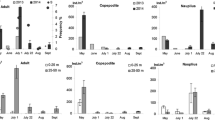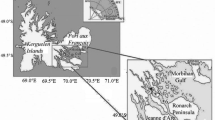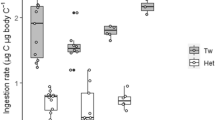Abstract
Seasonal lipid dynamics of various developmental stages were investigated in Pseudocalanus minutus and Oithona similis. For P. minutus, the dominance of 16:1(n−7), 16:4(n−3) and 20:5(n−3) fatty acids indicated a diatom-based nutrition in spring, whereas 22:6(n−3), 16:0, 18:2(n−6) and 18:1(n−9) pointed to a flagellate-based diet during the rest of the year as well as omnivorous/carnivorous low-level feeding during winter. The shorter-chain fatty alcohols 14:0 and 16:0 prevailed, also reflecting biosynthetic processes typical of omnivores or carnivores. Altogether, the lipid signatures characterized P. minutus as an opportunistic feeder. In contrast, O. similis had consistently high amounts of the 18:1(n−9) fatty acid in all stages and during all seasons pointing to a generally omnivorous/carnivorous/detritivorous diet. Furthermore, the fatty alcohol 20:1(n−9) reached high percentages especially in adult females and males, and feeding on Calanus faecal pellets is suggested. Fatty alcohols, as wax ester moieties, revealed significant seasonal variations in O. similis and a seasonal trend towards wax ester accumulation in autumn in P. minutus. P. minutus utilized its lipid deposits for development in the copepodite stages III and IV and for gonad maturation in CV and females during the dark season. However, CVs and females depended on the spring phytoplankton bloom for final maturation processes and reproduction. O. similis fueled gonad maturation and egg production for reproduction in June by wax esters, whereas reproduction in August/September co-occurred with the accumulation of new depot lipids. Both species revealed significantly higher wax ester levels in deeper (>50 m) as compared to surface (0–50 m) dwelling individuals related to a descent prior to overwintering.





Similar content being viewed by others
References
Albers CS, Kattner G, Hagen W (1996) The compositions of wax esters, triacylglycerols and phospholipids in Arctic and Antarctic copepods: Evidence of energetic adaptations. Mar Chem 55(3–4):347–358
Auel H, Harjes M, Da Rocha R, Stübing D, Hagen W (2002) Lipid biomarkers indicate different ecological niches and trophic relationships of the Arctic hyperiid amphipods Themisto abyssorum and T. libellula. Polar Biol 25:374–383
Båmstedt U, Håkanson JL, Brenner-Larsen J, Bjoernsen PK, Geertz-Hansen O, Tiselius P (1990) Copepod nutritional condition and pelagic production during autumn in Kosterfjorden, western Sweden. Mar Biol 104:197–208
Bedo AW, Head EJH, Conover RJ, Horne EPW, Harris LR (1990) Physiological adaptations of an under-ice population of Pseudocalanus in Barrow Strait (N.W.T.) to increasing food supply in spring. Polar Biol 10:561–570
Clarke A (1983) Life in cold water: the physiological ecology of polar marine ectotherms. Oceanogr Mar Biol Ann Rev 21:341–453
Clarke KR, Warwick RM (1994) Change in marine communities: an approach to statistical analysis and interpretation. Natural Environment Research Council, Plymouth, 144pp
Conover RJ, Huntley M (1991) Copepods in ice-covered sea—distribution, adaptations to seasonally limited food, metabolism, growth patterns and life cycle strategies in polar seas. J Mar Syst 2(1–2):1–41
Corkett CJ, McLaren IA (1978) The biology of Pseudocalanus. Adv Mar Biol 15:1–231
Dalsgaard J, St. John M, Kattner G, Müller-Navarra D, Hagen W (2003) Fatty acid trophic markers in the pelagic marine environment. Adv Mar Biol 46:225–340
Eaton JM (1971) Studies on the feeding and reproductive biology of the marine cyclopoid copepod Oithona similis, Claus. Ph.D. thesis. Dalhousie University, Halifax, 101pp
Falk-Petersen S, Sargent JR, Tande KS (1987) Lipid composition of zooplankton in relation to the sub-Arctic food web. Polar Biol 8:115–120
Falk-Petersen S, Hopkins CCE, Sargent JR (1990) Trophic relationships in the pelagic, Arctic food web. In: Barnes MA, Gibson RN (eds) Proceedings of the 24th European marine biology symposium. Aberdeen University Press, Aberdeen, pp 315–333
Falk-Petersen S, Sargent JR, Kwasniewski S, Gulliksen B, Millar RM (2001) Lipids and fatty acids in Clione limacina and Limacina helicina in Svalbard waters and the Arctic Ocean: trophic implications. Polar Biol 24:163–170
Fransz HG (1988) Vernal abundance, structure and development of epipelagic copepod populations of the eastern Weddell Sea (Antarctica). Polar Biol 99:107–114
Fraser AJ, Sargent JR, Gamble JC (1989) Lipid class and fatty acid composition of Calanus finmarchicus (Gunnerus), Pseudocalanus sp. and Temora longicornis Muller from a nutrient-enriched seawater enclosure. J Exp Mar Biol Ecol 130:81–92
Gallienne CP, Robins DB (2001) Is Oithona the most important copepod in the world’s oceans? J Plankton Res 23:1421–1432
González HE, Smetacek V (1994) The possible role of the cyclopoid copepod Oithona in retarding vertical flux of zooplankton faecal material. Mar Ecol Prog Ser 113:233–246
Graeve M, Kattner G, Hagen W (1994a) Diet-induced changes in the fatty acid composition of Arctic herbivorous copepods: experimental evidence of trophic markers. J Exp Mar Biol Ecol 182:97–110
Graeve M, Hagen W, Kattner G (1994b) Herbivorous or omnivorous? On the significance of lipid compositions as trophic markers in Antarctic copepods. Deep Sea Res 41(5–6):915–924
Graeve M, Kattner G, Piepenburg D (1997) Lipids in Arctic benthos: does the fatty acid and alcohol composition reflect feeding and trophic interactions? Polar Biol 18:53–61
Hagen W (1988) Zur Bedeutung der Lipide im antarktischen Zooplankton. Doctoral thesis. Institut für Polarökologie, Universität Kiel, 169pp
Hagen W (1999) Reproductive strategies and energetic adaptation of polar zooplankton. Invertebr Reprod Dev 36(1–3):25–34
Hagen W (2000) Lipids. In: Harris RP, Wiebe PH, Lenz J, Skjoldal HR, Huntley M (eds) ICES zooplankton methodology manual. Academic, San Diego, pp 113–119
Hagen W, Schnack-Schiel SB (1996) Seasonal lipid dynamics in dominant Antarctic copepods: energy for overwintering or reproduction? Deep-Sea Res 43:139–158
Hagen W, Kattner G, Graeve M (1993) Calanoides acutus and Calanus propinquus, Antarctic copepods with different lipid storage modes via wax esters or triacylglycerols. Mar Ecol Prog Ser 97:135–142
Harvey HR, Eglinton G, O’Hara SCM, Corner EDS (1987) Biotransformation and assimilation of dietary lipids by Calanus feeding on a dinoflagellate. Geochim Cosmochim Acta 51:3031–3040
Hop H, Pearson T, Hegseth EN, Kovacs KM, Wiencke C, Kwasniewski S, Eiane K, Mehlum F, Gulliksen B, Wlodarska-Kowalczuk M, Lydersen C, Weslawski JM, Cochrane S, Gabrielsen GW, Leakey RJG, Lønne OJ, Zajaczkowski M, Falk-Petersen S, Kendall M, Wängberg S-Å, Bischof K, Voronkov AY, Kovaltchouk NA, Wiktor J, Poltermann M, di Prisco G, Papucci C, Gerland S (2002) The marine ecosystem of Kongsfjorden, Svalbard. Polar Res 21:167–208
Irigoien X (2004) Some ideas about the role of lipids in the life cycle of Calanus finmarchicus. J Plankton Res 26:259–263
Kattner G, Fricke HSG (1986) Simple gas-liquid chromatographic method for the simultaneous determination of fatty acids and alcohols in wax esters of marine organisms. J Chromatogr 361:263–268
Kattner G, Hagen W (1995) Polar herbivorous copepods—different pathways in lipid biosynthesis. ICES J Mar Sci 52:329–335
Kattner G, Krause M (1989) Seasonal variations of lipids (wax esters, fatty acids and alcohols) in calanoid copepods from the North Sea. Mar Chem 26:261–275
Kattner G, Gercken G, Eberlein K (1983) Development of lipids during a spring plankton bloom in the northern North Sea. I. Particulate fatty acids. Mar Chem 14:149–162
Kattner G, Albers C, Graeve M, Schnack-Schiel SB (2003) Fatty acid and alcohol composition of the small polar copepods, Oithona and Oncaea: indication on feeding modes. Polar Biol 26:666–671
Lampitt RS, Gamble JC (1982) Diet and respiration of the small planktonic marine copepod Oithona nana. Mar Biol 66:185–190
Lee RF (1974) Lipid composition of the copepod Calanus hyperboreas from the Arctic Ocean. Changes with depth and season. Mar Biol 26:313–318
Lee RF, Hirota J (1973) Wax esters in tropical zooplankton and nekton and the geographical distribution of wax esters in marine copepods. Limnol Oceanogr 18:227–239
Lee RF, Hirota J, Barnett AM (1971a) Distribution and importance of wax esters in marine copepods and other zooplankton. Deep Sea Res 18:1147–1165
Lee RF, Nevenzel JC, Paffenhöfer GA (1971b) Importance of wax esters and other lipids in the marine food chain: phytoplankton and copepods. Mar Biol 9:99–108
Lee RF, Hagen W, Kattner G (2006) Lipid storage in marine zooplankton. Mar Ecol Prog Ser 307:273–306
Lischka S, Hagen W (2005) Life histories of the copepods Pseudocalanus minutus, P. acuspes (Calanoida) and Oithona similis (Cyclopoida) in the Arctic Kongsfjorden (Svalbard). Polar Biol 28:910–921
Nielsen TG, Andersen CM (2002) Plankton community structure and production along a freshwater-influenced Norwegian fjord system. Mar Biol 141:707–724
Norrbin F (1987) Overwintering and energetic strategies of marine pelagic copepods in high latitudes. Master’s thesis. University of Göteborg
Norrbin MF, Olsen R-E, Tande KS (1990) Seasonal variation in lipid class and fatty acid composition of two small copepods in Balsfjorden, northern Norway. Mar Biol 105:205–211
Obermüller B (1999) Charakterisierung arktischer Mesozooplanktongemeinschaften während einer Winter-/Frühjahrs-Übergangsperiode. Master’s thesis, Institute for Polar Ecology, University of Kiel, 112pp
Okolodkov YB, Hapter R, Semovski SV (2000) Phytoplankton in Kongsfjorden, Spitsbergen, July 1996. Sarsia 85:345–352
Paffenhöfer GA (1993) On the ecology of marine cyclopoid copepods (Crustacea, Copepoda). J Plankton Res 15:37–55
Peters J, Tuschling K, Brandt A (2004) Zooplankton in the Arctic Laptev Sea—feeding ecology as indicated by fatty acid composition. J Plankton Res 26:227–234
Poulet SA (1974) Seasonal grazing of Pseudocalanus minutus on particles. Mar Biol 25:109–123
Prahl FG, Eglinton G, Corner EDS, O’Hara SCM, Forsberg TEV (1984) Changes in plant lipids during passage through the gut of Calanus. J Mar Biol Assoc UK 64:317–334
Prahl FG, Eglinton G, Corner EDS, O’Hara SCM (1985) Faecal lipids released by fish feeding on zooplankton. J Mar Biol Assoc UK 65:547–560
Reigstad M, Wexels Riser C, Svensen C (2005) Fate of copepod faecal pellets and the role of Oithona spp. Mar Ecol Prog Ser 304:265–270
Reuss N, Poulsen LK (2002) Evaluation of fatty acids as biomarkers for a natural plankton community. A field study of a spring bloom and a post-bloom period off West Greenland. Mar Biol 141:423–434
Sargent JR, Henderson RJ (1986) Lipids. In: Corner EDS, O’Hara SCM (eds) The biological chemistry of marine copepods. Clarendon Press, Oxford, pp 59–108
Sargent JR, Gatten RR, Henderson RJ (1981) Lipid biochemistry of zooplankton from high latitudes. Océanis 7:623–632
Scott CL, Falk-Petersen S, Sargent JR, Hop H, Lønne OJ, Poltermann M (1999) Lipids and trophic interactions of ice fauna and pelagic zooplankton in the marginal ice zone of the Barents Sea. Polar Biol 21:65–70
Scott CL, Kwasniewski S, Falk-Petersen S, Sargent JR (2000) Lipids and life strategies of Calanus finmarchicus, Calanus glacialis and Calanus hyperboreus in late autumn, Kongsfjorden, Svalbard. Polar Biol 23:510–516
Scott CL, Kwasniewski S, Falk-Petersen S, Sargent JR (2002) Lipids and fatty acids in the copepod Jaschnovia brevis (Jaschnov) and in particulates from Arctic waters. Polar Biol 25:65–71
Wiktor J (1999) Early spring microplankton development under fast ice covered fjords of Svalbard, Arctic. Oceanologia 41:51–72
Acknowledgments
We thank UNIS on Svalbard, especially Dr. Ole-Jørgen Lønne, for all support during the sampling period. Petra Wencke and Janna Peters from the Marine Zoology in Bremen are gratefully acknowledged for their invaluable support and help during the lipid analyses and fruitful discussions of the data. Dr. Martin Graeve (Alfred Wegener Institute, Bremerhaven) is acknowledged for identifying unknown peaks by GC-MS. Thanks are also due to Dr. Dieter Piepenburg (Institute for Polar Ecology, Kiel) for statistical advice and to Dr. Holger Auel (Marine Zoology, Bremen) for critical comments on the manuscript. We also thank two anonymous reviewers for their comments on the manuscript. The 1-year sampling period on Svalbard was supported by the Deutsche Forschungsgemeinschaft (HA 1706/4-1).
Author information
Authors and Affiliations
Corresponding author
Additional information
Communicated by O. Kinne, Oldendorf/Luhe
Rights and permissions
About this article
Cite this article
Lischka, S., Hagen, W. Seasonal lipid dynamics of the copepods Pseudocalanus minutus (Calanoida) and Oithona similis (Cyclopoida) in the Arctic Kongsfjorden (Svalbard). Mar Biol 150, 443–454 (2007). https://doi.org/10.1007/s00227-006-0359-4
Received:
Accepted:
Published:
Issue Date:
DOI: https://doi.org/10.1007/s00227-006-0359-4




